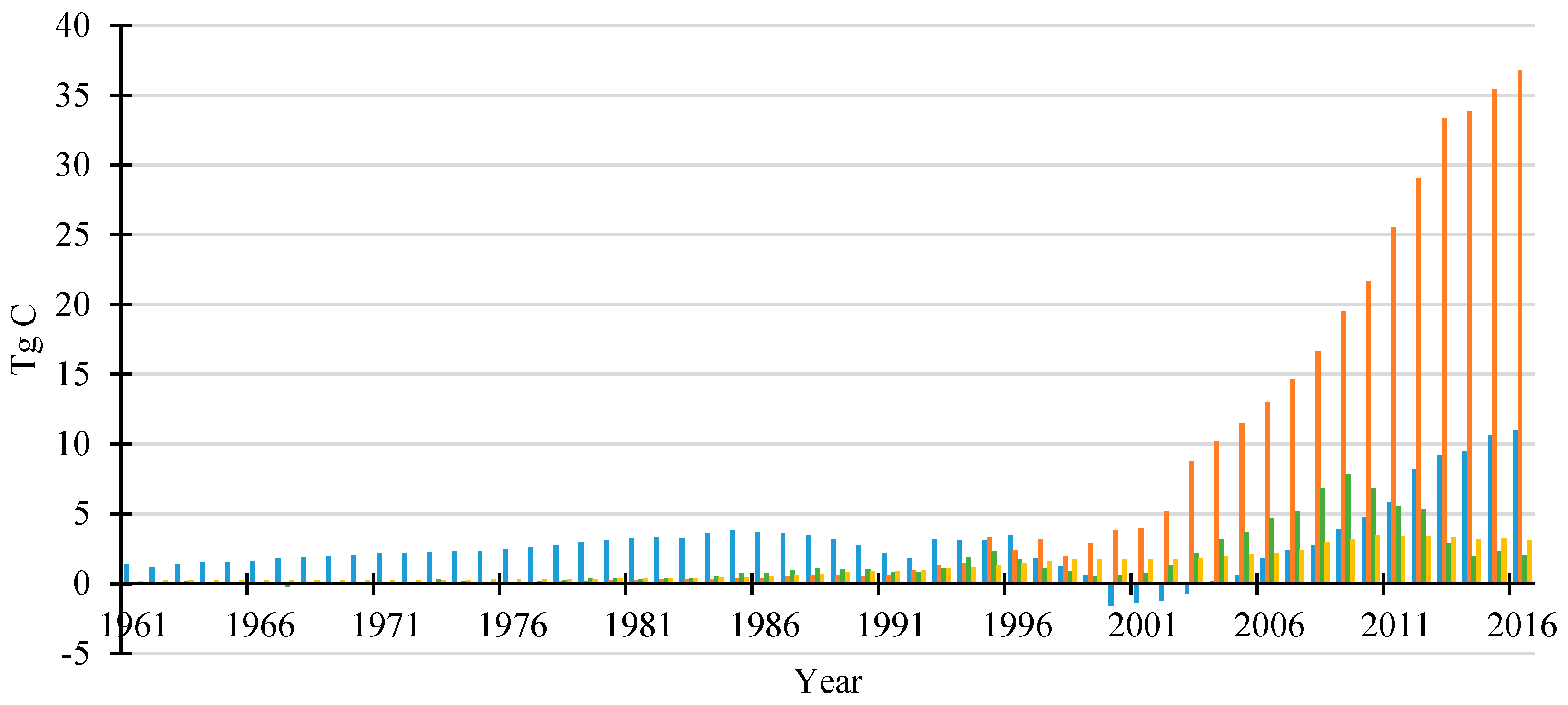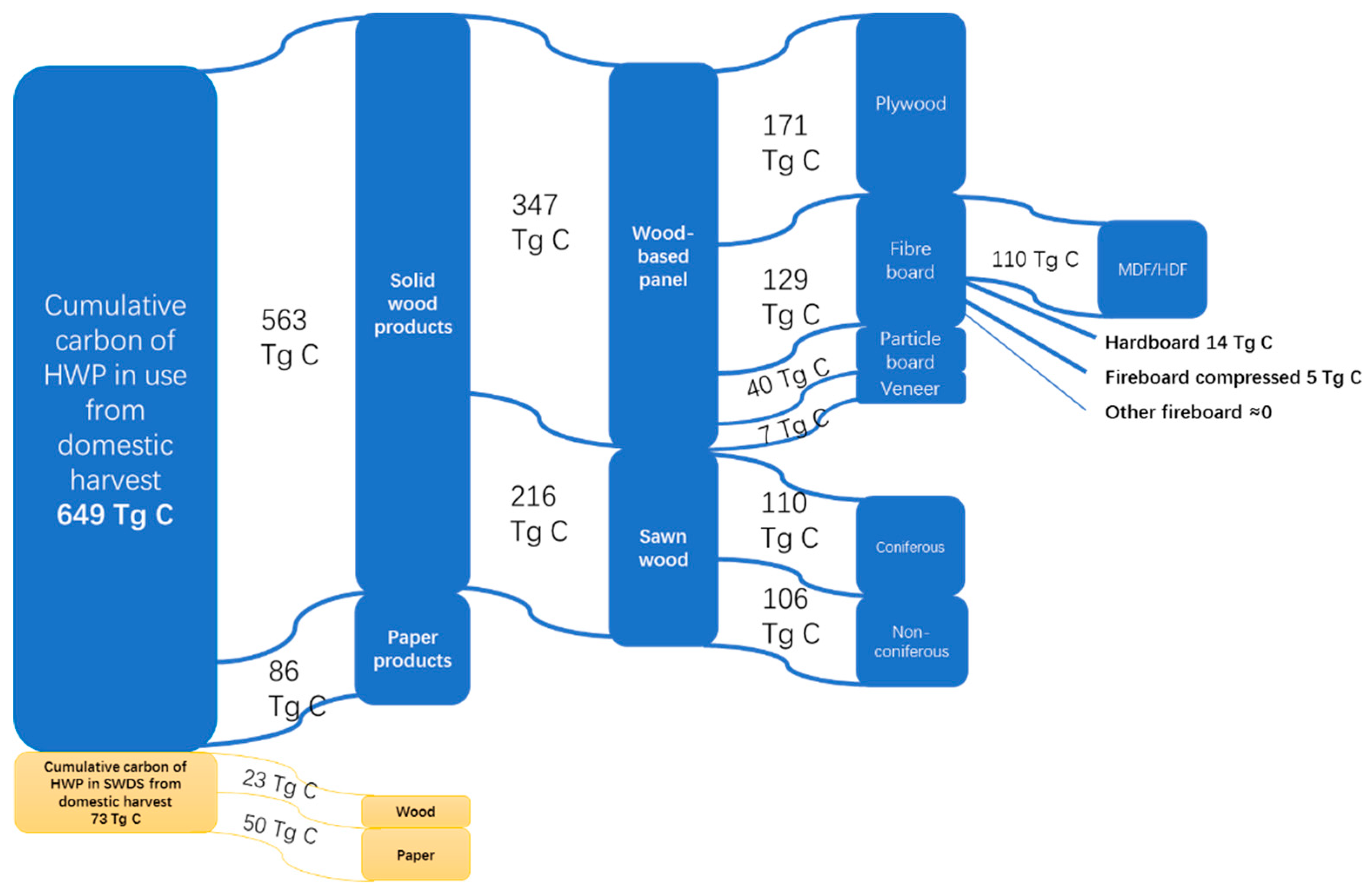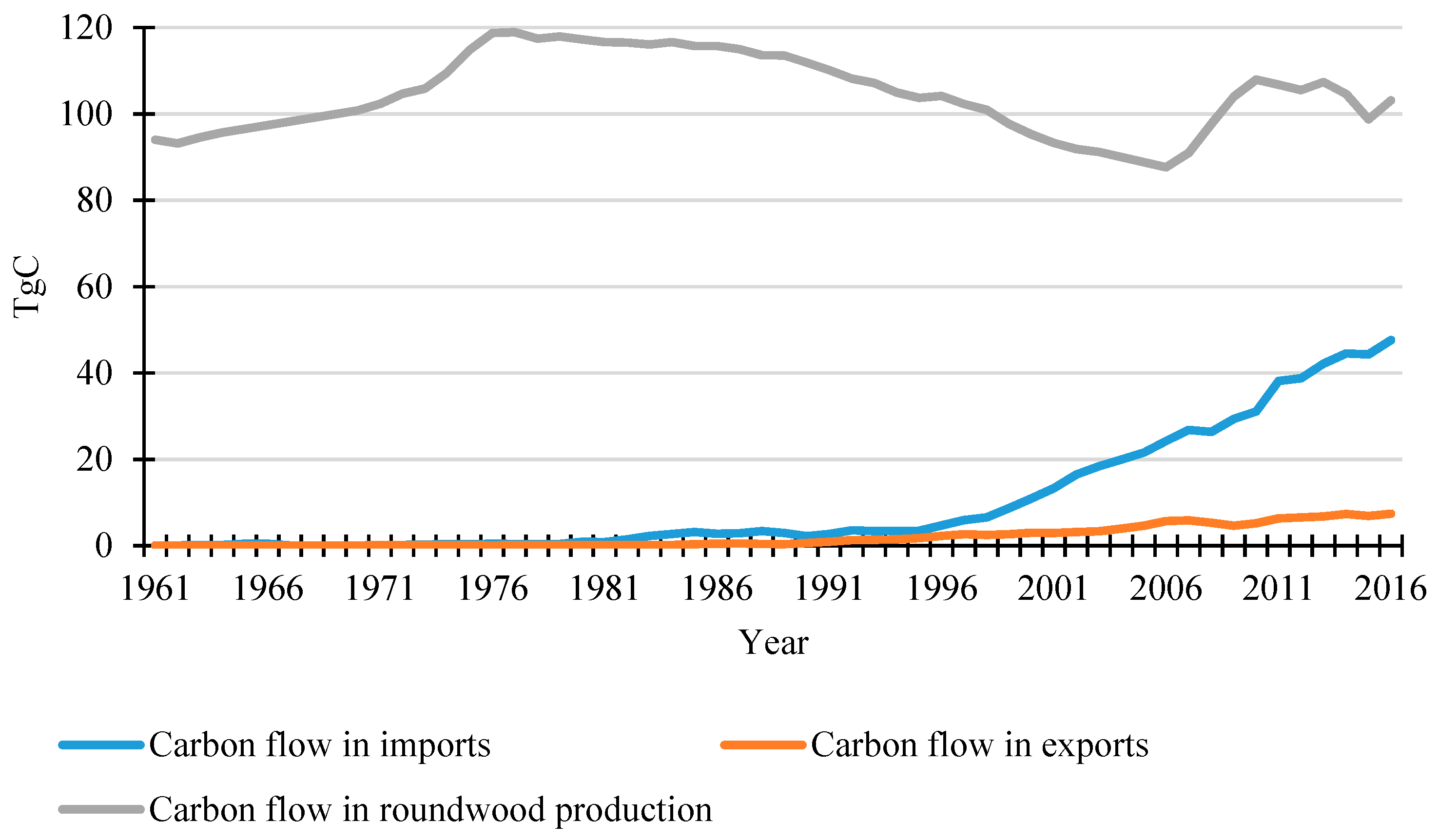Harvested Wood Products as a Carbon Sink in China, 1900–2016
Abstract
1. Introduction
2. Materials and Methods
2.1. Annual Change in Carbon Stock in “Products in Use”
2.2. Annual Change in Carbon Stock in Solid Waste Disposal Sites (SWDS)
2.3. HWP Contributes to Carbon Removals and Emissions
2.4. Data Sources
- Solid wood products including sawnwood and wood-based panels, and
- Paper products, such as paper & paperboard.
3. Results
3.1. Carbon Stock and Its Annual Change Stored in HWP
3.2. Carbon Flow in Roundwood Production, Imports and Exports in China
3.3. Carbon Emissions from HWP after Use
4. Discussion
4.1. Impacts of the Estimation Approach and Implications for Policy
4.2. Comparison with Previous Studies
4.3. Limitations
5. Conclusions
Author Contributions
Funding
Conflicts of Interest
References
- Köhl, M.; Lasco, R.; Cifuentes, M.; Jonsson, Ö.; Korhonen, K.T.; Mundhenk, P.; de Jesus Navar, J.; Stinson, G. Changes in forest production, biomass and carbon: Results from the 2015 UN FAO Global Forest Resource Assessment. For. Ecol. Manag. 2015, 352, 21–34. [Google Scholar] [CrossRef]
- Forest Products Statistics. Available online: http://www.fao.org/forestry/statistics/80938/en/ (accessed on 15 January 2019).
- IPCC. Climate Change 1995: Impacts, Adaptations and Mitigation of Climate Change: Scientific-Technical Analyses; IPCC: Cambridge, UK, 1996. [Google Scholar]
- Lim, B.; Brown, S.; Schlamadinger, B. Carbon accounting for forest harvesting and wood products: Review and evaluation of different approaches. Environ. Sci. Policy 1999, 2, 207–216. [Google Scholar] [CrossRef]
- Pingoud, K.; Soimakallio, S.; Perälä, A.L.; Pussinen, A. Greenhouse Gas Impacts of Harvested Wood Products. Evaluation and Development of Methods; Valtion Teknillinen Tutkimuskeskus: Espoo, Finland, 2003. [Google Scholar]
- IPCC. Good Practice Guidance for Land-Use, Land-Use Change and Forestry, Prepared by the National Greenhouse Gas Inventories Programme; IGES: Hayama, Japan, 2003. [Google Scholar]
- IPCC. 2006 IPCC Guidelines for National Greenhouse Gas Inventories—A Primer. Available online: https://www.ipcc-nggip.iges.or.jp/support/Primer_2006GLs.pdf (accessed on 27 January 2019).
- IPCC. 2013 Revised Supplementary Methods and Good Practice Guidance Arising from the Kyoto Protocol; IPCC: Geneva, Switzerland, 2014. [Google Scholar]
- FAO. 2016 Global Forest Products Facts and Figures. Available online: http://www.fao.org/3/I7034EN/i7034en.pdf (accessed on 28 November 2018).
- Sun, X.; Canby, K.; Liu, L. China’s Logging Ban in Natural Forests: Impacts of Extended Policy at Home and Abroad. Available online: https://www.forest-trends.org/wp-content/uploads/imported/chinas-logging-ban-in-natural-forests-final-3-14-2016-pdf.pdf (accessed on 28 November 2018).
- Williams, R.A. A stand density diagram for eucalyptus plantations in Guangxi, China. Agric. Res. Technol. 2017, 5, 555657. [Google Scholar] [CrossRef]
- Bai, Y.; Jiang, C.; Zhang, S. Carbon stock and potential of emission reduction of harvested wood products in China. Acta Ecol. Sin. 2009, 29, 399–405. [Google Scholar]
- Yang, H.; Zhang, X.A. Rethinking of the production approach in IPCC: Its objectiveness in China. Sustainability 2016, 8, 216. [Google Scholar] [CrossRef]
- Ji, C.; Cao, W.; Chen, Y.; Yang, H. Carbon balance and contribution of harvested wood products in China based on the production approach of the intergovernmental panel on climate change. Int. J. Environ. Res. Public Health 2016, 13, 1132. [Google Scholar] [CrossRef] [PubMed]
- Zhang, X.; Yang, H.; Chen, J. Life-cycle carbon budget of China’s harvested wood products in 1900–2015. For. Policy Econ. 2018, 92, 181–192. [Google Scholar] [CrossRef]
- IPCC. 2006 IPCC Guidelines for National Greenhouse Gas Inventories. Available online: https://www.ipcc-nggip.iges.or.jp/public/2006gl/index.html (accessed on 27 January 2019).
- Mitchell, C. Estimation, reporting and accounting of harvested wood products. In United Nations Framework Convention on Climate Change Reports; UNFCCC: Bonn, Germany, 2003; pp. 17–22. [Google Scholar]
- Zhao, J.; Guo, J.; Xu, J.; Mao, F.; Yang, X.; Zhang, Y. Trends of Chinese dry-wet condition based on wetness index. Trans. Chin. Soc. Agric. Eng. (Trans. CSAE) 2010, 26, 18–24. [Google Scholar] [CrossRef]
- Cai, B.; Liu, J.; Zeng, X.; Cao, D.; Liu, L.; Zhou, Y.; Zhang, Z. Estimation of CH4 emissions from landfills in china based on point emission sources. Progress. Inquis. Mutat. Clim. 2013, 9, 406–413. [Google Scholar]
- Zhang, Y. China Circular Economy Yearbook 2016; Metallurgical Industry Press: Beijing, China, 2017. [Google Scholar]
- Dias, A.C.; Louro, M.; Arroja, L.; Capela, I. Carbon estimation in harvested wood products using a country-specific method: Portugal as a case study. Environ. Sci. Policy 2007, 10, 250–259. [Google Scholar] [CrossRef]
- Jasinevičius, G.; Lindner, M.; Cienciala, E.; Tykkyläinen, M. Carbon accounting in harvested wood products: Assessment using material flow analysis resulting in larger pools compared to the IPCC default method. J. Ind. Ecol. 2018, 22, 121–131. [Google Scholar] [CrossRef]
- Meng, C. China Circular Economy Yearbook 2017; Metallurgical Industry Press: Beijing, China, 2018. [Google Scholar]
- Bache-Andreassen, L. Harvested Wood Products in The Context of Climate Change. Available online: https://core.ac.uk/download/pdf/30887740.pdf (accessed on 28 November 2018).
- Skog, K.E. Sequestration of carbon in harvested wood products for the United States. For. Prod. J. 2008, 58, 56–72. [Google Scholar]
- IPCC. Climate Change 2013: The Physical Science Basis. Contribution of Working Group I to the Fifth Assessment Report of the Intergovernmental Panel on Climate Change; Stocker, T.F., Qin, D., Plattner, G.-K., Tignor, M., Allen, S.K., Boschung, J., Nauels, A., Xia, Y., Bex, V., Midgley, P.M., Eds.; Cambridge University Press: Cambridge, UK; New York, NY, USA, 2013. [Google Scholar] [CrossRef]
- Mayers, J. The Dragon and the Giraffe: China in African Forests. Available online: http://pubs.iied.org/17302IIED/ (accessed on 28 November 2018).






| HWP Categories | C Conversion Factor |
|---|---|
| (per air dry volume) [Mg C/m3] | |
| Sawnwood (aggregate) | 0.229 |
| Coniferous sawnwood | 0.225 |
| Non-coniferous sawnwood | 0.28 |
| Wood-based panels (aggregate) | 0.269 |
| Hardboard | 0.335 |
| Other fiberboard | 0.075 |
| Fiberboard compressed | 0.315 |
| MDF/HDF 1 | 0.315 |
| Particle board | 0.269 |
| Plywood | 0.267 |
| Veneer sheets | 0.253 |
| (per air dry mass) [Mg C/Mg] | |
| Paper & paperboard (aggregate) | 0.386 |
| Charcoal | 0.765 |
| Roundwood (aggregate, Industrial roundwood, pulpwood, chips, particles, wood fuel, wood residues 2 | 0.26 |
| Coniferous roundwood | 0.225 |
| Non-coniferous roundwood | 0.295 |
| Year | Combustion | Unmanaged, Shallow | Unmanaged, Deep |
|---|---|---|---|
| 1900–1980 | 0% | 100% | 0% |
| 1981 | 0% | 97% | 3% |
| 1982 | 0% | 93% | 7% |
| 1983 | 0% | 90% | 10% |
| 1984 | 0% | 87% | 13% |
| 1985 | 0% | 84% | 16% |
| 1986 | 0% | 80% | 20% |
| 1987 | 0% | 77% | 23% |
| 1988 | 0% | 74% | 26% |
| 1989 | 0% | 70% | 30% |
| 1990 | 0% | 67% | 33% |
| 1991 | 0% | 64% | 36% |
| 1992 | 0% | 60% | 40% |
| 1993 | 0% | 57% | 43% |
| 1994 | 0% | 54% | 46% |
| 1995 | 0% | 51% | 49% |
| 1996 | 0% | 47% | 53% |
| 1997 | 0% | 44% | 56% |
| 1998 | 0% | 41% | 59% |
| 1999 | 0% | 37% | 63% |
| 2000 | 0% | 34% | 66% |
| 2001 | 0% | 31% | 69% |
| 2002 | 0% | 28% | 72% |
| 2003 | 0% | 24% | 76% |
| 2004 | 1% | 19% | 80% |
| 2005 | 4% | 13% | 83% |
| 2006 | 7% | 7% | 87% |
| 2007 | 10% | 0% | 90% |
| 2008 | 10% | 0% | 90% |
| 2009 | 13% | 0% | 87% |
| 2010 | 14% | 0% | 86% |
| 2011 | 16% | 0% | 84% |
| 2012 | 21% | 0% | 79% |
| 2013 | 27% | 0% | 73% |
| 2014 | 30% | 0% | 70% |
| 2015 | 34% | 0% | 66% |
| 2016 | 37% | 0% | 63% |
© 2019 by the authors. Licensee MDPI, Basel, Switzerland. This article is an open access article distributed under the terms and conditions of the Creative Commons Attribution (CC BY) license (http://creativecommons.org/licenses/by/4.0/).
Share and Cite
Zhang, L.; Sun, Y.; Song, T.; Xu, J. Harvested Wood Products as a Carbon Sink in China, 1900–2016. Int. J. Environ. Res. Public Health 2019, 16, 445. https://doi.org/10.3390/ijerph16030445
Zhang L, Sun Y, Song T, Xu J. Harvested Wood Products as a Carbon Sink in China, 1900–2016. International Journal of Environmental Research and Public Health. 2019; 16(3):445. https://doi.org/10.3390/ijerph16030445
Chicago/Turabian StyleZhang, Luyang, Yankun Sun, Tianyuan Song, and Jiaqi Xu. 2019. "Harvested Wood Products as a Carbon Sink in China, 1900–2016" International Journal of Environmental Research and Public Health 16, no. 3: 445. https://doi.org/10.3390/ijerph16030445
APA StyleZhang, L., Sun, Y., Song, T., & Xu, J. (2019). Harvested Wood Products as a Carbon Sink in China, 1900–2016. International Journal of Environmental Research and Public Health, 16(3), 445. https://doi.org/10.3390/ijerph16030445




